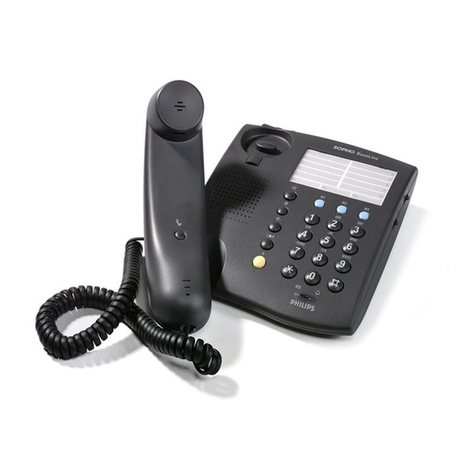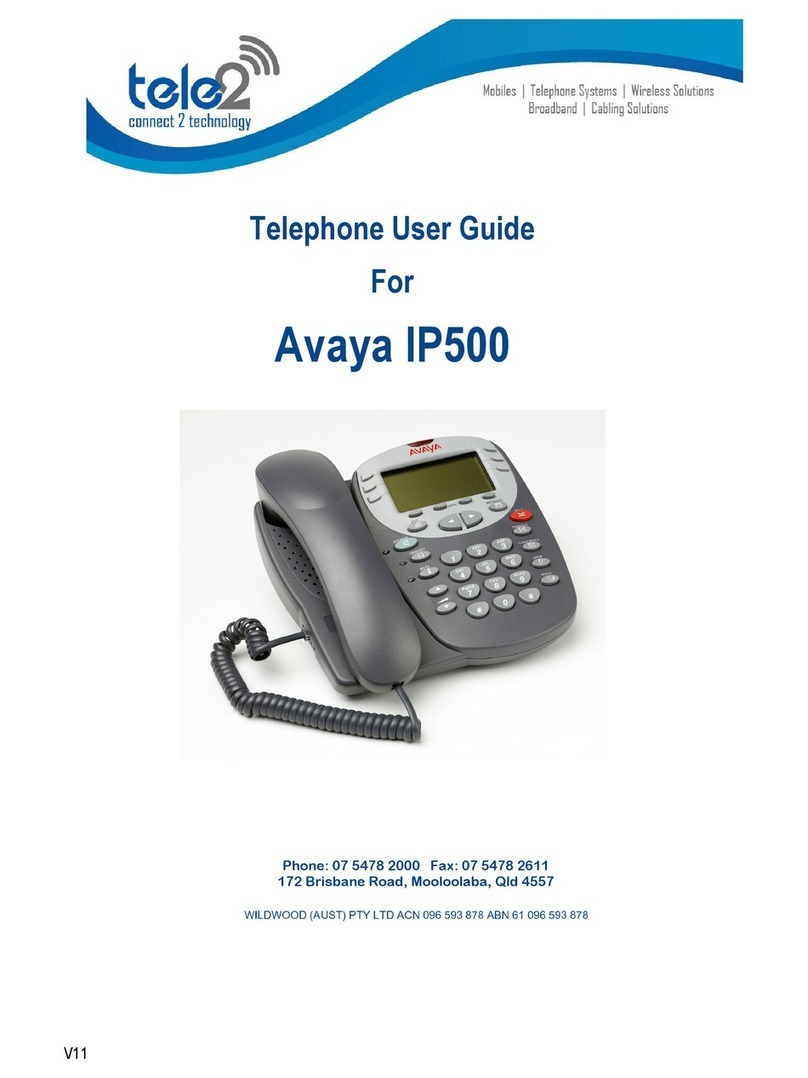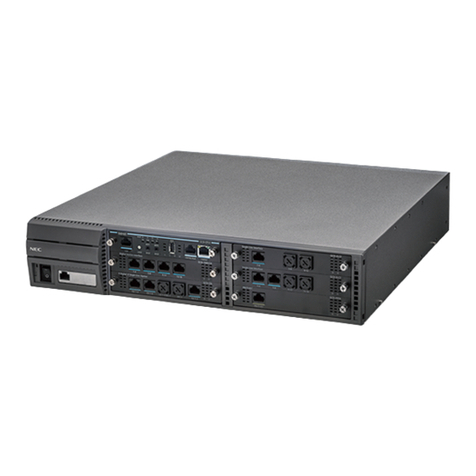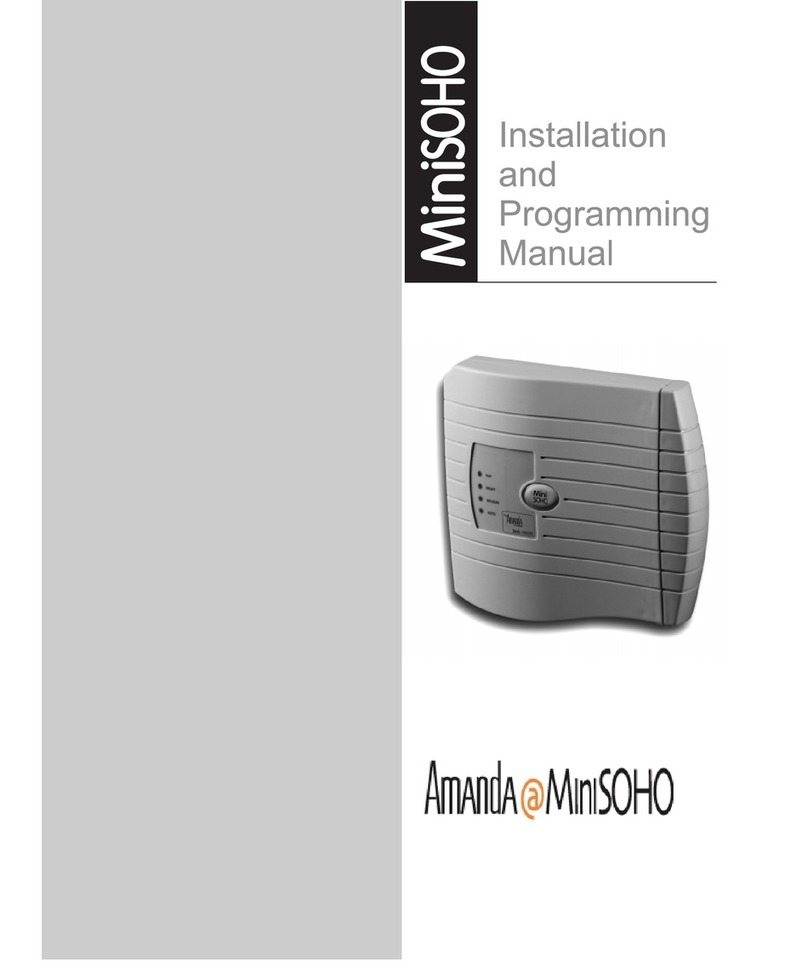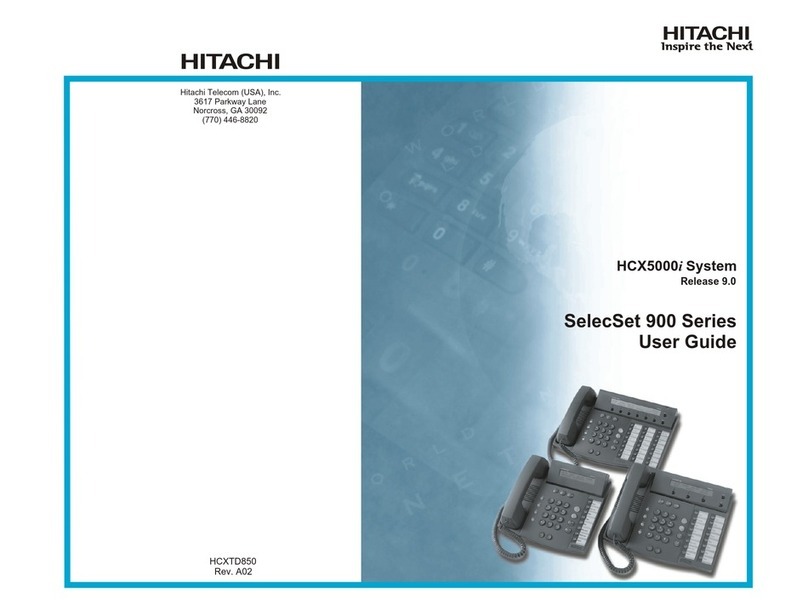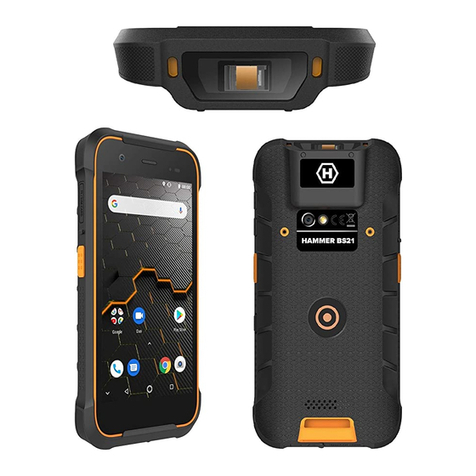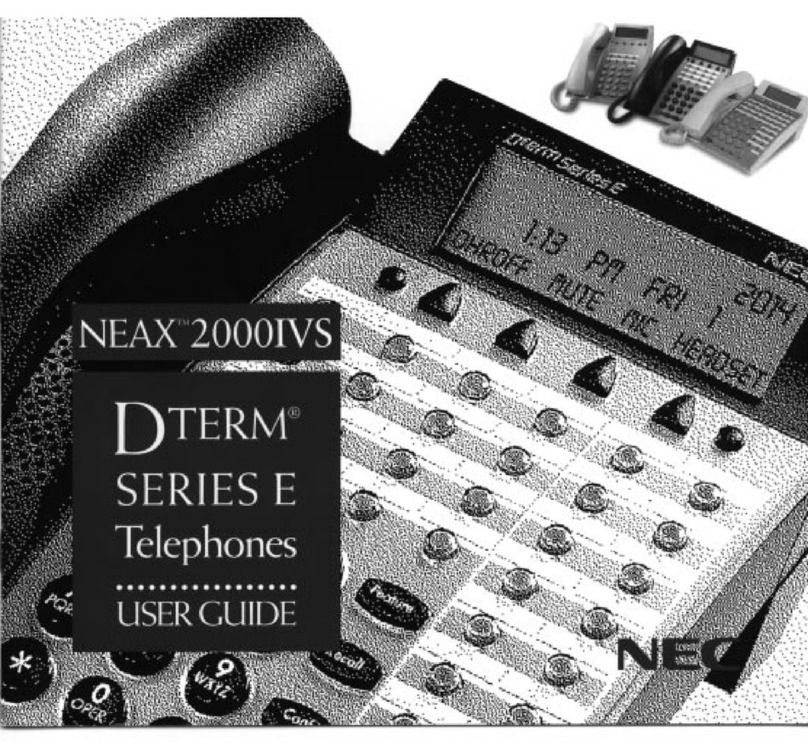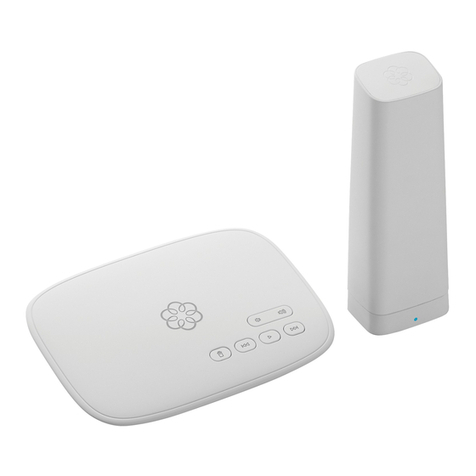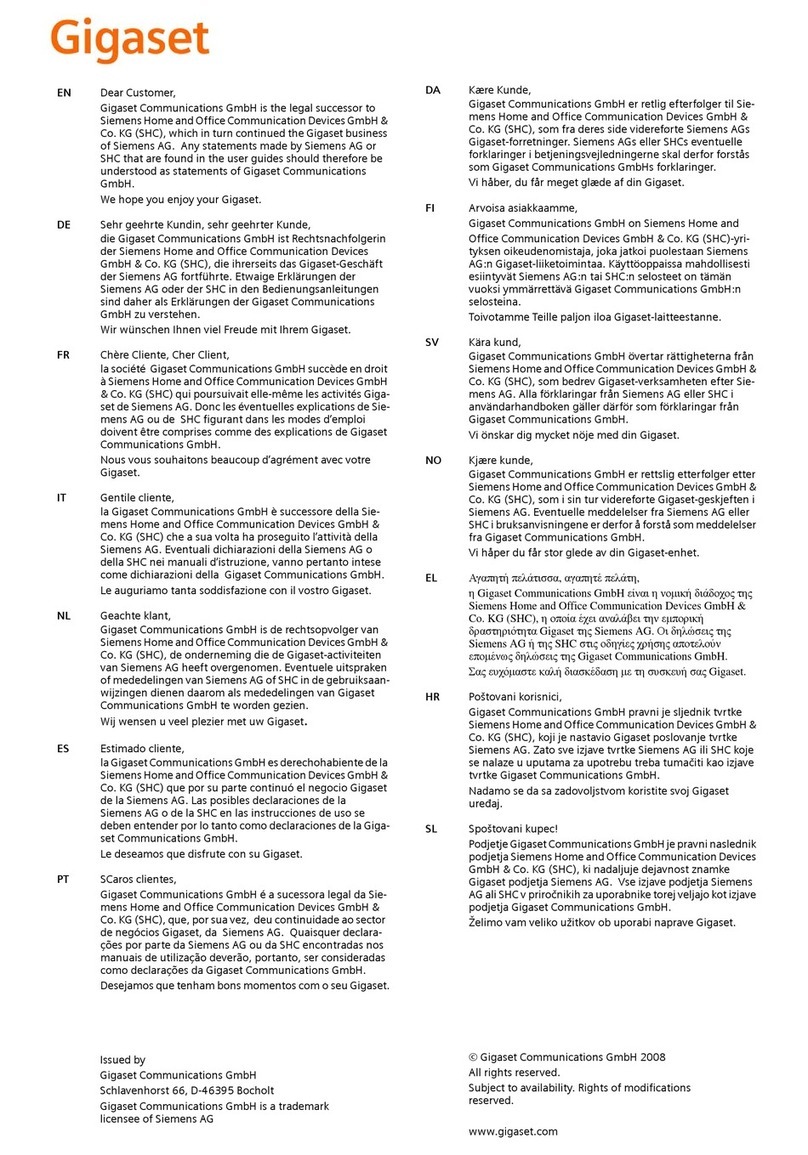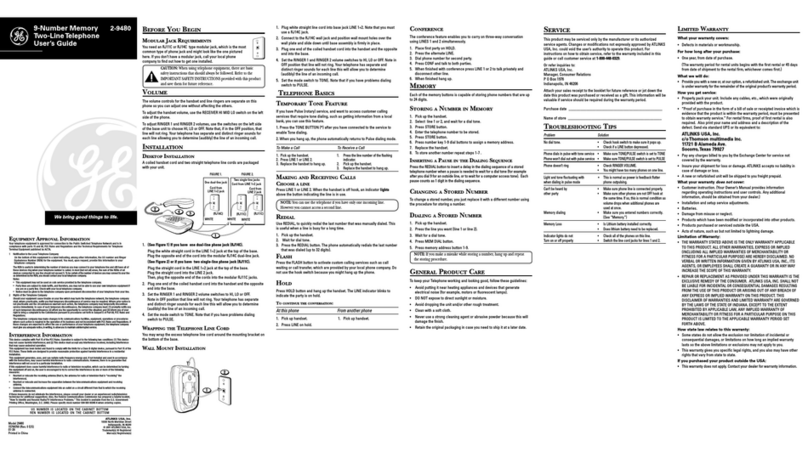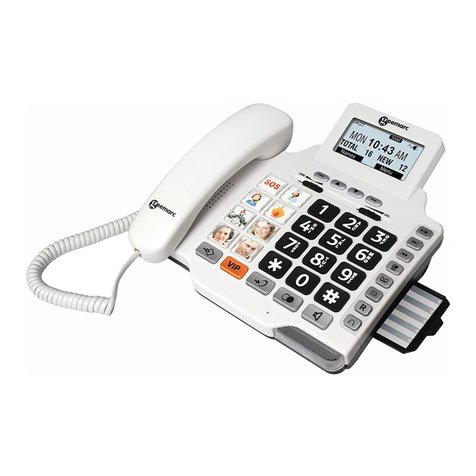Deutsche Telekom Octopus F100 User manual

================!"§==
Octopus F100/200/400/650
IP-Netpackage
Octophon F640 TDM
key module for Octophon F640
Octophon F640 Busy Lamp Field
Operating Instructions

Important information
2
Important information
Trademarks
Never open the telephone or a key module. Should you encounter any problems, contact the
responsible service personnel.
Use only original accessories. The use of other accessories may be hazardous and will ren-
der the warranty, extended manufacturer’s liability and the CE marking invalid.
The device conforms to the EU directive 1999/5/EC as attested by the CE marking.
All electrical and electronic products should be disposed of separately from the municipal
waste stream via designated collection facilities appointed by the government or the local au-
thorities.
Proper disposal and separate collection of your old appliance will help prevent potential
damage to the environment and human health. It is a prerequisite for reuse and recycling of
used electrical and electronic equipment.
For more detailed information about disposal of your old appliance, please contact your city
office, waste disposal service, the shop where you purchased the product or your sales rep-
resentative.
The statements quoted above are only fully valid for equipment which is installed and sold in
the countries of the European Union and is covered by the directive 2002/96/EC. Countries
outside the European Union may impose other regulations regarding the disposal of electri-
cal and electronic equipment.

Important information
3
Location of the telephone
• The telephone should be operated in a controlled environment with an ambient temperature between 5°C
and 40°C.
• To ensure good speakerphone quality, the area in front of the microphone (front right) should be kept clear.
The optimum speakerphone distance is 50 cm.
• Do not install the telephone in a room where large quantities of dust accumulate; this can considerably re-
duce the service life of the telephone.
• Do not expose the telephone to direct sunlight or any other source of heat, as this is liable to damage the
electronic components and the plastic casing.
• Do not operate the telephone in damp environments such as bathrooms.
Documentation
These operating instructions can be found on CD-ROM (ask the service personnel) in HTML and PDF format.
To view or print the operating manual in PDF format, you need a computer on which the free Adobe Acrobat
Reader program is installed.
To view the operating manual in HTML format, you need a computer with a Web browser, forexample, Microsoft
Internet Explorer.

4
Contents
Contents
Important information . . . . . . . . . . . . . . . . . . . . . . . . . . . 2
Trademarks . . . . . . . . . . . . . . . . . . . . . . . . . . . . . . . . . . . . . . . . . . . . . . . . . . . . . . . . . . . . . . . . . . . . . 2
Location of the telephone . . . . . . . . . . . . . . . . . . . . . . . . . . . . . . . . . . . . . . . . . . . . . . . . . . . . . . . . . 3
Documentation . . . . . . . . . . . . . . . . . . . . . . . . . . . . . . . . . . . . . . . . . . . . . . . . . . . . . . . . . . . . . . . . . . 3
General information. . . . . . . . . . . . . . . . . . . . . . . . . . . . 10
About this manual . . . . . . . . . . . . . . . . . . . . . . . . . . . . . . . . . . . . . . . . . . . . . . . . . . . . . . . . . . . . . . . 10
Service. . . . . . . . . . . . . . . . . . . . . . . . . . . . . . . . . . . . . . . . . . . . . . . . . . . . . . . . . . . . . . . . . . . . . . . . . 10
Intended use . . . . . . . . . . . . . . . . . . . . . . . . . . . . . . . . . . . . . . . . . . . . . . . . . . . . . . . . . . . . . . . . . . . 11
Telephone type . . . . . . . . . . . . . . . . . . . . . . . . . . . . . . . . . . . . . . . . . . . . . . . . . . . . . . . . . . . . . . . . . 11
Speakerphone quality and display legibility . . . . . . . . . . . . . . . . . . . . . . . . . . . . . . . . . . . . . . . . 11
Multi-line telephone, executive/secretary functions. . . . . . . . . . . . . . . . . . . . . . . . . . . . . . . . . . 11
Team functions . . . . . . . . . . . . . . . . . . . . . . . . . . . . . . . . . . . . . . . . . . . . . . . . . . . . . . . . . . . . . 11
Getting to know your Octophon F640 phone . . . . . . . 12
The User Interface of Your Octophon F640 TDM. . . . . . . . . . . . . . . . . . . . . . . . . . . . . . . . . . . . 12
Ports on the underside of the phone. . . . . . . . . . . . . . . . . . . . . . . . . . . . . . . . . . . . . . . . . . . . . . . 13
Key Module. . . . . . . . . . . . . . . . . . . . . . . . . . . . . . . . . . . . . . . . . . . . . . . . . . . . . . . . . . . . . . . . . . . . . 14
key module for Octophon F640 . . . . . . . . . . . . . . . . . . . . . . . . . . . . . . . . . . . . . . . . . . . . . . . 14
OpenStage Key Module 15. . . . . . . . . . . . . . . . . . . . . . . . . . . . . . . . . . . . . . . . . . . . . . . . . . . 15
Octophon F640 Busy Lamp Field . . . . . . . . . . . . . . . . . . . . . . . . . . . . . . . . . . . . . . . . . . . . . . . . . 16
Keys . . . . . . . . . . . . . . . . . . . . . . . . . . . . . . . . . . . . . . . . . . . . . . . . . . . . . . . . . . . . . . . . . . . . . . . . . . . 17
Function keys. . . . . . . . . . . . . . . . . . . . . . . . . . . . . . . . . . . . . . . . . . . . . . . . . . . . . . . . . . . . . . . 17
Audio keys . . . . . . . . . . . . . . . . . . . . . . . . . . . . . . . . . . . . . . . . . . . . . . . . . . . . . . . . . . . . . . . . . 17
5-way navigator . . . . . . . . . . . . . . . . . . . . . . . . . . . . . . . . . . . . . . . . . . . . . . . . . . . . . . . . . . . . . 18
Programmable sensor keys . . . . . . . . . . . . . . . . . . . . . . . . . . . . . . . . . . . . . . . . . . . . . . . . . . 19
Keypad . . . . . . . . . . . . . . . . . . . . . . . . . . . . . . . . . . . . . . . . . . . . . . . . . . . . . . . . . . . . . . . . . . . . 20
Display. . . . . . . . . . . . . . . . . . . . . . . . . . . . . . . . . . . . . . . . . . . . . . . . . . . . . . . . . . . . . . . . . . . . . . . . . 22
Idle mode . . . . . . . . . . . . . . . . . . . . . . . . . . . . . . . . . . . . . . . . . . . . . . . . . . . . . . . . . . . . . . . . . . 22
Telephony dialogs. . . . . . . . . . . . . . . . . . . . . . . . . . . . . . . . . . . . . . . . . . . . . . . . . . . . . . . . . . . 24
Mailbox . . . . . . . . . . . . . . . . . . . . . . . . . . . . . . . . . . . . . . . . . . . . . . . . . . . . . . . . . . . . . . . . . . . . . . . . 26
Messages . . . . . . . . . . . . . . . . . . . . . . . . . . . . . . . . . . . . . . . . . . . . . . . . . . . . . . . . . . . . . . . . . . 26
Voicemail . . . . . . . . . . . . . . . . . . . . . . . . . . . . . . . . . . . . . . . . . . . . . . . . . . . . . . . . . . . . . . . . . . 26
Caller list . . . . . . . . . . . . . . . . . . . . . . . . . . . . . . . . . . . . . . . . . . . . . . . . . . . . . . . . . . . . . . . . . . . . . . . 27
Menu . . . . . . . . . . . . . . . . . . . . . . . . . . . . . . . . . . . . . . . . . . . . . . . . . . . . . . . . . . . . . . . . . . . . . . . . . . 28
Program/Service menu . . . . . . . . . . . . . . . . . . . . . . . . . . . . . . . . . . . . . . . . . . . . . . . . . . . . . . 28
Call preparation. . . . . . . . . . . . . . . . . . . . . . . . . . . . . . . . . . . . . . . . . . . . . . . . . . . . . . . . . . . . . 29
Call pop-up . . . . . . . . . . . . . . . . . . . . . . . . . . . . . . . . . . . . . . . . . . . . . . . . . . . . . . . . . . . . . . . . . 30
Audio accessories. . . . . . . . . . . . . . . . . . . . . . . . . . . . . . . . . . . . . . . . . . . . . . . . . . . . . . . . . . . 31

Contents
5
Basic functions . . . . . . . . . . . . . . . . . . . . . . . . . . . . . . . 32
Answering a call . . . . . . . . . . . . . . . . . . . . . . . . . . . . . . . . . . . . . . . . . . . . . . . . . . . . . . . . . . . . . . . . 32
Answering a call via the handset . . . . . . . . . . . . . . . . . . . . . . . . . . . . . . . . . . . . . . . . . . . . . . 32
Answering a call via the loudspeaker (speakerphone mode). . . . . . . . . . . . . . . . . . . . . . 33
Accepting a call via the headset . . . . . . . . . . . . . . . . . . . . . . . . . . . . . . . . . . . . . . . . . . . . . . . 33
Switching to speakerphone mode . . . . . . . . . . . . . . . . . . . . . . . . . . . . . . . . . . . . . . . . . . . . . . . . 34
Switching to the handset . . . . . . . . . . . . . . . . . . . . . . . . . . . . . . . . . . . . . . . . . . . . . . . . . . . . . . . . 34
Open listening during a call. . . . . . . . . . . . . . . . . . . . . . . . . . . . . . . . . . . . . . . . . . . . . . . . . . . . . . 34
Making calls . . . . . . . . . . . . . . . . . . . . . . . . . . . . . . . . . . . . . . . . . . . . . . . . . . . . . . . . . . . . . . . . . . . 35
Off-hook dialing . . . . . . . . . . . . . . . . . . . . . . . . . . . . . . . . . . . . . . . . . . . . . . . . . . . . . . . . . . . . . 35
On-hook dialing . . . . . . . . . . . . . . . . . . . . . . . . . . . . . . . . . . . . . . . . . . . . . . . . . . . . . . . . . . . . . 35
Dialing with the headset connected. . . . . . . . . . . . . . . . . . . . . . . . . . . . . . . . . . . . . . . . . . . . 36
Dialing with DDS keys. . . . . . . . . . . . . . . . . . . . . . . . . . . . . . . . . . . . . . . . . . . . . . . . . . . . . . . . 36
Redialing a number . . . . . . . . . . . . . . . . . . . . . . . . . . . . . . . . . . . . . . . . . . . . . . . . . . . . . . . . . . . . . 37
Ending a call . . . . . . . . . . . . . . . . . . . . . . . . . . . . . . . . . . . . . . . . . . . . . . . . . . . . . . . . . . . . . . . . . . . 38
Rejecting calls . . . . . . . . . . . . . . . . . . . . . . . . . . . . . . . . . . . . . . . . . . . . . . . . . . . . . . . . . . . . . . . . . 38
Turning the microphone on and off . . . . . . . . . . . . . . . . . . . . . . . . . . . . . . . . . . . . . . . . . . . . . . . 38
Calling a second party (consultation) . . . . . . . . . . . . . . . . . . . . . . . . . . . . . . . . . . . . . . . . . . . . . 39
Switching to the held party (alternating) . . . . . . . . . . . . . . . . . . . . . . . . . . . . . . . . . . . . . . . . 39
Transferring a call . . . . . . . . . . . . . . . . . . . . . . . . . . . . . . . . . . . . . . . . . . . . . . . . . . . . . . . . . . . 40
Call forwarding . . . . . . . . . . . . . . . . . . . . . . . . . . . . . . . . . . . . . . . . . . . . . . . . . . . . . . . . . . . . . . . . . 41
Using variable call forwarding. . . . . . . . . . . . . . . . . . . . . . . . . . . . . . . . . . . . . . . . . . . . . . . . . 41
Using call forwarding no reply (CFNR) . . . . . . . . . . . . . . . . . . . . . . . . . . . . . . . . . . . . . . . . . 42
Call forwarding in the carrier network and
forwarding multiple subscriber numbers (MSN) . . . . . . . . . . . . . . . . . . . . . . . . . . . . . . . . 43
Using callback . . . . . . . . . . . . . . . . . . . . . . . . . . . . . . . . . . . . . . . . . . . . . . . . . . . . . . . . . . . . . . . . . 44
Storing a callback . . . . . . . . . . . . . . . . . . . . . . . . . . . . . . . . . . . . . . . . . . . . . . . . . . . . . . . . . . . 44
Accepting a callback. . . . . . . . . . . . . . . . . . . . . . . . . . . . . . . . . . . . . . . . . . . . . . . . . . . . . . . . . 44
Viewing and deleting a stored callback . . . . . . . . . . . . . . . . . . . . . . . . . . . . . . . . . . . . . . . . 45
Enhanced phone functions . . . . . . . . . . . . . . . . . . . . . 46
Answering calls . . . . . . . . . . . . . . . . . . . . . . . . . . . . . . . . . . . . . . . . . . . . . . . . . . . . . . . . . . . . . . . . 46
Accepting a call with the headset. . . . . . . . . . . . . . . . . . . . . . . . . . . . . . . . . . . . . . . . . . . . . . 46
Accepting a specific call for your colleague. . . . . . . . . . . . . . . . . . . . . . . . . . . . . . . . . . . . . 46
Using the speakerphone . . . . . . . . . . . . . . . . . . . . . . . . . . . . . . . . . . . . . . . . . . . . . . . . . . . . .47
Answering calls from the entrance telephone
and opening the door . . . . . . . . . . . . . . . . . . . . . . . . . . . . . . . . . . . . . . . . . . . . . . . . . . . . . . . . 48
Accepting a call from an answering machine . . . . . . . . . . . . . . . . . . . . . . . . . . . . . . . . . . . 49
Making calls . . . . . . . . . . . . . . . . . . . . . . . . . . . . . . . . . . . . . . . . . . . . . . . . . . . . . . . . . . . . . . . . . . . 50
En-bloc sending/correcting numbers . . . . . . . . . . . . . . . . . . . . . . . . . . . . . . . . . . . . . . . . . . 50
Using the caller list. . . . . . . . . . . . . . . . . . . . . . . . . . . . . . . . . . . . . . . . . . . . . . . . . . . . . . . . . . . 51
Dialing a number from the internal directory . . . . . . . . . . . . . . . . . . . . . . . . . . . . . . . . . . . . 52
Using the LDAP directory (not for HiPath 500) . . . . . . . . . . . . . . . . . . . . . . . . . . . . . . . . . . 53
Making calls using system speed-dial numbers . . . . . . . . . . . . . . . . . . . . . . . . . . . . . . . . . 55
Dialing with speed-dial keys . . . . . . . . . . . . . . . . . . . . . . . . . . . . . . . . . . . . . . . . . . . . . . . . . .55
Talking to your colleague with a speaker call . . . . . . . . . . . . . . . . . . . . . . . . . . . . . . . . . . . 56

6
Contents
Talking to your colleague with discreet calling . . . . . . . . . . . . . . . . . . . . . . . . . . . . . . . . . 57
Automatic connection setup (hotline). . . . . . . . . . . . . . . . . . . . . . . . . . . . . . . . . . . . . . . . . . 57
Reserving a trunk . . . . . . . . . . . . . . . . . . . . . . . . . . . . . . . . . . . . . . . . . . . . . . . . . . . . . . . . . . . 57
Assigning a station number . . . . . . . . . . . . . . . . . . . . . . . . . . . . . . . . . . . . . . . . . . . . . . . . . . 58
Associated dialing/dialing aid . . . . . . . . . . . . . . . . . . . . . . . . . . . . . . . . . . . . . . . . . . . . . . . . 58
During a call . . . . . . . . . . . . . . . . . . . . . . . . . . . . . . . . . . . . . . . . . . . . . . . . . . . . . . . . . . . . . . . . . . . . 59
Using call waiting (second call) . . . . . . . . . . . . . . . . . . . . . . . . . . . . . . . . . . . . . . . . . . . . . . . 59
Preventing and allowing call waiting (automatic camp-on) . . . . . . . . . . . . . . . . . . . . . . . 60
Turning the call waiting tone on and off . . . . . . . . . . . . . . . . . . . . . . . . . . . . . . . . . . . . . . . . 60
Saving a number . . . . . . . . . . . . . . . . . . . . . . . . . . . . . . . . . . . . . . . . . . . . . . . . . . . . . . . . . . . 60
Parking a call . . . . . . . . . . . . . . . . . . . . . . . . . . . . . . . . . . . . . . . . . . . . . . . . . . . . . . . . . . . . . . . 61
Holding external calls. . . . . . . . . . . . . . . . . . . . . . . . . . . . . . . . . . . . . . . . . . . . . . . . . . . . . . . . 62
Conducting a conference . . . . . . . . . . . . . . . . . . . . . . . . . . . . . . . . . . . . . . . . . . . . . . . . . . . . 63
Activating tone dialing/DTMF suffix-dialing. . . . . . . . . . . . . . . . . . . . . . . . . . . . . . . . . . . . . 64
Recording a call. . . . . . . . . . . . . . . . . . . . . . . . . . . . . . . . . . . . . . . . . . . . . . . . . . . . . . . . . . . . . 65
Transferring a call after a speaker call announcement in a group . . . . . . . . . . . . . . . . . 66
Send trunk flash . . . . . . . . . . . . . . . . . . . . . . . . . . . . . . . . . . . . . . . . . . . . . . . . . . . . . . . . . . . . 67
If you cannot reach a destination. . . . . . . . . . . . . . . . . . . . . . . . . . . . . . . . . . . . . . . . . . . . . . . . . . 68
Call waiting (camp-on) . . . . . . . . . . . . . . . . . . . . . . . . . . . . . . . . . . . . . . . . . . . . . . . . . . . . . . . 68
Busy override – joining a call in progress. . . . . . . . . . . . . . . . . . . . . . . . . . . . . . . . . . . . . . . 68
Using night answer . . . . . . . . . . . . . . . . . . . . . . . . . . . . . . . . . . . . . . . . . . . . . . . . . . . . . . . . . . . . . . 69
Programming a sensor key . . . . . . . . . . . . . . . . . . . . . . . . . . . . . . . . . . . . . . . . . . . . . . . . . . . . . . . 70
Configuring function keys . . . . . . . . . . . . . . . . . . . . . . . . . . . . . . . . . . . . . . . . . . . . . . . . . . . . . . . . 70
Overview of functions. . . . . . . . . . . . . . . . . . . . . . . . . . . . . . . . . . . . . . . . . . . . . . . . . . . . . . . . 71
Programming a procedure key. . . . . . . . . . . . . . . . . . . . . . . . . . . . . . . . . . . . . . . . . . . . . . . . . . . . 73
Configuring repdial keys . . . . . . . . . . . . . . . . . . . . . . . . . . . . . . . . . . . . . . . . . . . . . . . . . . . . . . . . . 75
Changing the label . . . . . . . . . . . . . . . . . . . . . . . . . . . . . . . . . . . . . . . . . . . . . . . . . . . . . . . . . . . . . . 76
Deleting sensor key programming . . . . . . . . . . . . . . . . . . . . . . . . . . . . . . . . . . . . . . . . . . . . . . . . 77
Displaying and assigning call charges . . . . . . . . . . . . 78
Displaying call charges . . . . . . . . . . . . . . . . . . . . . . . . . . . . . . . . . . . . . . . . . . . . . . . . . . . . . . . . . . 78
Displaying call charges for another telephone . . . . . . . . . . . . . . . . . . . . . . . . . . . . . . . . . . . . . . 79
Dialing with call charge assignment . . . . . . . . . . . . . . . . . . . . . . . . . . . . . . . . . . . . . . . . . . . . . . . 80
Privacy/security. . . . . . . . . . . . . . . . . . . . . . . . . . . . . . . 81
Turning ringer cutoff on and off . . . . . . . . . . . . . . . . . . . . . . . . . . . . . . . . . . . . . . . . . . . . . . . . . . . 81
Activating/deactivating "Do not disturb". . . . . . . . . . . . . . . . . . . . . . . . . . . . . . . . . . . . . . . . . . . . 81
Caller ID suppression . . . . . . . . . . . . . . . . . . . . . . . . . . . . . . . . . . . . . . . . . . . . . . . . . . . . . . . . . . . . 82
Silent Monitor . . . . . . . . . . . . . . . . . . . . . . . . . . . . . . . . . . . . . . . . . . . . . . . . . . . . . . . . . . . . . . . . . . 82
Monitoring a room. . . . . . . . . . . . . . . . . . . . . . . . . . . . . . . . . . . . . . . . . . . . . . . . . . . . . . . . . . . . . . . 83
Trace call: identifying anonymous callers . . . . . . . . . . . . . . . . . . . . . . . . . . . . . . . . . . . . . . . . . . 83
Locking the telephone to prevent unauthorized use . . . . . . . . . . . . . . . . . . . . . . . . . . . . . . . . . 84
Locking another telephone to prevent unauthorized use. . . . . . . . . . . . . . . . . . . . . . . . . . . . . 85
Saving your PIN . . . . . . . . . . . . . . . . . . . . . . . . . . . . . . . . . . . . . . . . . . . . . . . . . . . . . . . . . . . . . . . . . 86

Contents
7
More functions/services. . . . . . . . . . . . . . . . . . . . . . . . 87
Appointments function . . . . . . . . . . . . . . . . . . . . . . . . . . . . . . . . . . . . . . . . . . . . . . . . . . . . . . . . . . 87
Saving appointments . . . . . . . . . . . . . . . . . . . . . . . . . . . . . . . . . . . . . . . . . . . . . . . . . . . . . . . . 87
Using timed reminders . . . . . . . . . . . . . . . . . . . . . . . . . . . . . . . . . . . . . . . . . . . . . . . . . . . . . . . 88
Sending a message. . . . . . . . . . . . . . . . . . . . . . . . . . . . . . . . . . . . . . . . . . . . . . . . . . . . . . . . . . . . . 88
Creating and sending a message. . . . . . . . . . . . . . . . . . . . . . . . . . . . . . . . . . . . . . . . . . . . . . 88
Viewing and editing incoming messages . . . . . . . . . . . . . . . . . . . . . . . . . . . . . . . . . . . . . . . 89
Leaving an advisory message . . . . . . . . . . . . . . . . . . . . . . . . . . . . . . . . . . . . . . . . . . . . . . . . . . . . 90
Deleting advisory messages . . . . . . . . . . . . . . . . . . . . . . . . . . . . . . . . . . . . . . . . . . . . . . . . . . 90
Displaying the number of waiting calls/overload display . . . . . . . . . . . . . . . . . . . . . . . . . . . . 91
Using another telephone like your own for a call . . . . . . . . . . . . . . . . . . . . . . . . . . . . . . . . . . . 91
Fax details and message on answering machine . . . . . . . . . . . . . . . . . . . . . . . . . . . . . . . . . . . 93
Resetting services and functions (system-wide cancellation for a telephone) . . . . . . . . . . 93
Activating functions for another telephone. . . . . . . . . . . . . . . . . . . . . . . . . . . . . . . . . . . . . . . . . 94
Using system functions from outside DISA (direct inward system access) . . . . . . . . . . . . . 95
Using functions in ISDN via code dialing (keypad dialing) . . . . . . . . . . . . . . . . . . . . . . . . . . . 96
Controlling connected computers/programs/telephone data service. . . . . . . . . . . . . . . . . 97
Communicating with PC applications over a CSTA interface. . . . . . . . . . . . . . . . . . . . . . . . . 98
Controlling relays (only for Octopus F100/200/400/650) . . . . . . . . . . . . . . . . . . . . . . . . . . . 99
Sensors (Octopus F100/200/400 only) . . . . . . . . . . . . . . . . . . . . . . . . . . . . . . . . . . . . . . . . . . . 99
Paging persons . . . . . . . . . . . . . . . . . . . . . . . . . . . . . . . . . . . . . . . . . . . . . . . . . . . . . . . . . . . . . . . 100
Making calls in the team/executive/
secretary configuration . . . . . . . . . . . . . . . . . . . . . . . 101
Lines . . . . . . . . . . . . . . . . . . . . . . . . . . . . . . . . . . . . . . . . . . . . . . . . . . . . . . . . . . . . . . . . . . . . . . . . . 101
Line utilization. . . . . . . . . . . . . . . . . . . . . . . . . . . . . . . . . . . . . . . . . . . . . . . . . . . . . . . . . . . . . .101
Line seizure. . . . . . . . . . . . . . . . . . . . . . . . . . . . . . . . . . . . . . . . . . . . . . . . . . . . . . . . . . . . . . . .101
Trunk keys. . . . . . . . . . . . . . . . . . . . . . . . . . . . . . . . . . . . . . . . . . . . . . . . . . . . . . . . . . . . . . . . . . . . 102
Answering calls with the trunk keys . . . . . . . . . . . . . . . . . . . . . . . . . . . . . . . . . . . . . . . . . . .103
Dialing with trunk keys . . . . . . . . . . . . . . . . . . . . . . . . . . . . . . . . . . . . . . . . . . . . . . . . . . . . . .103
Placing a call on hold on a trunk key and retrieving the held call . . . . . . . . . . . . . . . . .103
Making calls on multiple lines alternately . . . . . . . . . . . . . . . . . . . . . . . . . . . . . . . . . . . . . .104
MULAP conference release. . . . . . . . . . . . . . . . . . . . . . . . . . . . . . . . . . . . . . . . . . . . . . . . . .104
Direct station selection key . . . . . . . . . . . . . . . . . . . . . . . . . . . . . . . . . . . . . . . . . . . . . . . . . . . . . 105
Using DSS keys to answer calls . . . . . . . . . . . . . . . . . . . . . . . . . . . . . . . . . . . . . . . . . . . . . .105
Calling a team member directly . . . . . . . . . . . . . . . . . . . . . . . . . . . . . . . . . . . . . . . . . . . . . .105
Transferring a call in progress. . . . . . . . . . . . . . . . . . . . . . . . . . . . . . . . . . . . . . . . . . . . . . . .106
Accepting a call for another team member . . . . . . . . . . . . . . . . . . . . . . . . . . . . . . . . . . . .106
Forwarding calls on trunks. . . . . . . . . . . . . . . . . . . . . . . . . . . . . . . . . . . . . . . . . . . . . . . . . . . . . . 107
Transferring calls directly to the executive phone. . . . . . . . . . . . . . . . . . . . . . . . . . . . . . . . . . 109

8
Contents
Using team functions. . . . . . . . . . . . . . . . . . . . . . . . . . 110
Activating/deactivating a group call . . . . . . . . . . . . . . . . . . . . . . . . . . . . . . . . . . . . . . . . . . . . . . 110
Accepting a call for another member of your team . . . . . . . . . . . . . . . . . . . . . . . . . . . . . . . . . 112
Ringing group . . . . . . . . . . . . . . . . . . . . . . . . . . . . . . . . . . . . . . . . . . . . . . . . . . . . . . . . . . . . . . . . . 112
Uniform Call Distribution (UCD) . . . . . . . . . . . . . . . . . . . . . . . . . . . . . . . . . . . . . . . . . . . . . . . . . . 113
Special functions in the LAN . . . . . . . . . . . . . . . . . . . 115
Leaving hunt group/group call. . . . . . . . . . . . . . . . . . . . . . . . . . . . . . . . . . . . . . . . . . . . . . . . . . . 115
Setting up "follow me" call forwarding . . . . . . . . . . . . . . . . . . . . . . . . . . . . . . . . . . . . . . . . . . . . 116
Using night answer . . . . . . . . . . . . . . . . . . . . . . . . . . . . . . . . . . . . . . . . . . . . . . . . . . . . . . . . . . . . . 117
Ringing group . . . . . . . . . . . . . . . . . . . . . . . . . . . . . . . . . . . . . . . . . . . . . . . . . . . . . . . . . . . . . . . . . 118
Controlling relays (only for Octopus F100/200/400/650) . . . . . . . . . . . . . . . . . . . . . . . . . . . 119
Opening a door . . . . . . . . . . . . . . . . . . . . . . . . . . . . . . . . . . . . . . . . . . . . . . . . . . . . . . . . . . . . . . . . 120
Individual phone configuration . . . . . . . . . . . . . . . . . 121
Adjusting display settings . . . . . . . . . . . . . . . . . . . . . . . . . . . . . . . . . . . . . . . . . . . . . . . . . . . . . . . 121
Adjusting the display to a comfortable reading angle . . . . . . . . . . . . . . . . . . . . . . . . . . . 121
Illuminated display . . . . . . . . . . . . . . . . . . . . . . . . . . . . . . . . . . . . . . . . . . . . . . . . . . . . . . . . . 121
Setting contrast . . . . . . . . . . . . . . . . . . . . . . . . . . . . . . . . . . . . . . . . . . . . . . . . . . . . . . . . . . . . 121
Adjusting displays on the Open Stage Key Module. . . . . . . . . . . . . . . . . . . . . . . . . . . . . . . . . 121
Adjusting audio settings . . . . . . . . . . . . . . . . . . . . . . . . . . . . . . . . . . . . . . . . . . . . . . . . . . . . . . . . 122
Adjusting the receiving volume during a call. . . . . . . . . . . . . . . . . . . . . . . . . . . . . . . . . . . 122
Adjusting the ring volume . . . . . . . . . . . . . . . . . . . . . . . . . . . . . . . . . . . . . . . . . . . . . . . . . . . 122
Adjusting the ring tone. . . . . . . . . . . . . . . . . . . . . . . . . . . . . . . . . . . . . . . . . . . . . . . . . . . . . . 122
Adjusting the attention ring volume. . . . . . . . . . . . . . . . . . . . . . . . . . . . . . . . . . . . . . . . . . . 123
Adjusting the speakerphone to the room acoustics . . . . . . . . . . . . . . . . . . . . . . . . . . . . 123
Activating/deactivating the ringer . . . . . . . . . . . . . . . . . . . . . . . . . . . . . . . . . . . . . . . . . . . . 123
Language for system functions . . . . . . . . . . . . . . . . . . . . . . . . . . . . . . . . . . . . . . . . . . . . . . . . . . 123
Testing the phone . . . . . . . . . . . . . . . . . . . . . . . . . . . . 124
Phone functions, testing . . . . . . . . . . . . . . . . . . . . . . . . . . . . . . . . . . . . . . . . . . . . . . . . . . . . . . . . 124
Checking the key assignment . . . . . . . . . . . . . . . . . . . . . . . . . . . . . . . . . . . . . . . . . . . . . . . . . . . 124
Differing display view
in a Octopus F900 environment . . . . . . . . . . . . . . . . . 125
Fixing problems . . . . . . . . . . . . . . . . . . . . . . . . . . . . . . 126
Responding to error messages on the screen . . . . . . . . . . . . . . . . . . . . . . . . . . . . . . . . . . . . . 126
Contact partner in the case of problems . . . . . . . . . . . . . . . . . . . . . . . . . . . . . . . . . . . . . . . . . . 127
Troubleshooting . . . . . . . . . . . . . . . . . . . . . . . . . . . . . . . . . . . . . . . . . . . . . . . . . . . . . . . . . . . . . . . 128
Caring for your telephone . . . . . . . . . . . . . . . . . . . . . . . . . . . . . . . . . . . . . . . . . . . . . . . . . . . . . . . 128

Contents
9
Index. . . . . . . . . . . . . . . . . . . . . . . . . . . . . . . . . . . . . . . 129
Overview of functions and codes. . . . . . . . . . . . . . . . 134
Display icons . . . . . . . . . . . . . . . . . . . . . . . . . . . . . . . . 139

General information
10
General information
About this manual
This document contains general descriptions of the technical options, which may not always
be available in individual cases. The respective features must therefore be individually de-
fined in the terms of the contract.
If a particular function on your phone is not available to you, this may be due to one of the
following reasons:
• The function is not configured for you or your telephone. Please contact your system
support representative.
• Your communications platform does not feature this function. Please contact your ser-
vice personnel for information on how to upgrade.
This user guide is intended to help you familiarize yourself with Octophon F640 and all of its
functions. It contains important information on the safe and proper operation of your
Octophon F640 phone. These instructions should be strictly complied with to avoid operat-
ing errors and ensure optimum use of your multifunctional telephone in the network.
These instructions should be read and followed by every person installing, operating or pro-
gramming an Octophon F640 phone.
This user guide is designed to be simple and easy to understand, providing clear step-by-
step instructions for operating your Octophon F640 phone.
Administrative tasks are dealt with in a separate manual. The Quick Reference Guide con-
tains quick and reliable explanations of frequently used functions.
Service
If you experience problems or defects with the phone, please dial the service number for
your country.
For your own protection, please read the section dealing with safety in detail. Follow
the safety instructions carefully in order to avoid endangering yourself or other per-
sons and to prevent damage to the unit.
The Siemens service department can only help you if you experience problems or
defects with the phone.
Should you have any questions regarding operation, your specialist retailer or net-
work administrator will gladly help you.
For queries regarding connection of the telephone, please contact your network pro-
vider.

General information
11
Intended use
The Octophon F640 phone was developed as a device for speech transmission and should
be placed on the desk or mounted on the wall. Any other use is regarded as unauthorized.
Telephone type
The identification details (exact product designation and serial number) of your telephone
can be found on the nameplate on the underside of the base unit. Specific details concern-
ing your communications platform can be obtained from your service technician.
Please have this information ready when you contact our service department regarding
faults or problems with the product.
Speakerphone quality and display legibility
• To ensure good speakerphone quality, the area in front of the telephone (front right)
should be kept clear.
The optimum handsfree distance is 20 in. (50 cm).
• Proceed as follows to optimize display legibility:
– Turn the phone to tilt the display. This ensures you have a frontal view of the display
while eliminating light reflexes.
Multi-line telephone, executive/secretary functions
Your Octophon F640 TDM is a "multi-line telephone". This means that your service personnel
can configure multiple lines on your phone, which is not the case with single-line phones.
Each line is assigned an individual phone number which you can use to make and receive
calls.
The programmable sensor keys function as line keys on multi-line phones ÆPage 102.
When using a multi-line phone to make and receive calls, certain particulars must be taken
into account ÆPage 103 ff.
The executive-secretary configuration is a special case. This is a multi-line telephone with
special features (e.g., "Ring Transfer" and "Accept call"), configured especially for executive/
secretary use ÆPage 101 ff.
Team functions
To increase the efficiency of telephony, your service personnel can configure various Team
functions such as pickup groups, hunt groups, and call distribution groups.

Getting to know your Octophon F640 phone
12
Getting to know your Octophon F640 phone
The following sections describe the most frequently used operating elements and the dis-
plays on your Octophon F640 phone.
The User Interface of Your Octophon F640 TDM
1 You can make and receive calls as normal using the handset.
2Thedisplay permits intuitive operation of the phone ÆPage 22.
3 You can customize your telephone by assigning phone numbers and functions to the
programmable sensor keys ÆPage 19.
4Youcanusefunction keys when conducting a call to access frequently used functions
(such as, Disconnect) or to open the Program/Service menu and mailbox ÆPage 17.
5Audio keys are also available, allowing you to optimally configure the audio features
on your telephone ÆPage 17.
6The5-way navigator is a convenient navigation tool ÆPage 18.
7Thekeypad can be used to enter phone numbers and text ÆPage 20.
8 Incoming calls are visually signaled via the call display.
5
7
1
6
4
8
23

Getting to know your Octophon F640 phone
13
Ports on the underside of the phone
Properties of your Octophon F640 TDM
Display type LCD, 40 x 6 characters
Illuminated display ;
Programmable sensor keys 6
Full-duplex speakerphone function ;
Headset ;
USB slave ;
Phone/analog adapter ;
Interface for key modules ;
Wall mounting ;
Headset
Busy Lamp field
key module Handset
USB slave
Octopus F/IP-Netpackage

Getting to know your Octophon F640 phone
14
Key Module
key module for Octophon F640
The key module for Octophon F640 is a key module attached to the side of the phone that
provides 12 additional illuminated, programmable keys.
Like keys on the phone, these keys can be programmed and used according to your needs
ÆPage 19.
You can attach up to two key module for Octophon F640s to your Octophon F640 TDM.
To operate a key module for Octophon F640, you always require a power supply
unit.

Getting to know your Octophon F640 phone
15
OpenStage Key Module 15
The OpenStage Key Module 15 is a key module attached to the side of the phone that pro-
vides an additional 18 illuminated, programmable sensor keys.
Like keys on the phone, these keys can be programmed and used according to your needs
You can only attach one OpenStage Key Module 15 to your Octophon F640 TDM. You can-
not mix the OpenStage Key Module 15 with the key module for Octophon F640.

Getting to know your Octophon F640 phone
16
Octophon F640 Busy Lamp Field
The Octophon F640 Busy Lamp Field is a key module attached to the side of the phone, that
provides 90 illuminated, programmable keys.
Like keys on the phone, these keys can be programmed and used according to your needs
ÆPage 19.
You can attach one Octophon F640 Busy Lamp Field to your Octophon F640 TDM.
Key label
Your Octophon F640 Busy Lamp Field is delivered with label strips. Write functions or names
in the white fields on the label strips.
Lay the labeled strips on the key fields and place the transparent cover over them (rough side
up).
Your Octophon F640 TDM can be configured as an attendant console in conjunc-
tion with an Octophon F640 Busy Lamp Field (ask your service personnel).
To operate a Octophon F640 Busy Lamp Field, you always require a power supply
unit.

Getting to know your Octophon F640 phone
17
Keys
Function keys
Audio keys
Key Function when key is pressed
sEnd (disconnect) call ÆPage 38.
,Redialing ÆPage 37.
rButton for call forwarding (with red LED key)[1] ÆPage 41.
[1] If the LED key flashes on the phone, your phone was configured as a forwarding destination.
OOpen mailbox (with red LED key) ÆPage 26.
NOpen telephone menu (with red LED key) ÆPage 28.
Key Function when key is pressed
oActivate/deactivate headset ÆPage 46.
pActivate/deactivate microphone (also for speakerphone mode) ÆPage 38.
-Set volume lower and contrast brighter ÆPage 121.
nTurn speaker on/off (with red LED key) ÆPage 34.
+Set volume louder and contrast darker ÆPage 121.

Getting to know your Octophon F640 phone
18
5-way navigator
With this control, you can manage most of your phone’s functions, as well as its displays.
Remove the protective film from the ring around the 5-way navigator before using the
phone.
Operation Functions when key is pressed
Press c
In idle mode:
• Open the idle menu ÆPage 23
In lists and menus:
• Go to next level
You can now access a context menu:
• Open the context menu
Press a
In lists and menus:
• go back one level or go back to the telepho-
ny interface by pressing several times
During en-bloc dialing:
• Delete character to the left of the cursor
Press d
In idle mode:
• Open the idle menu ÆPage 23
In lists and menus:
• Scroll down
• Long press (key held down): jump to the
end of the list/menu
Press b
In idle mode:
• Open the idle menu ÆPage 23
In lists and menus:
• Scroll up
• Long press (key held down): jump to the
start of the list/menu
Press i
In idle mode:
• Open the idle menu ÆPage 23
Entry selected:
•Performaction

Getting to know your Octophon F640 phone
19
Programmable sensor keys
Your Octophon F640 TDM has six illuminated sensor keys. You can assign functions and
phone numbers to them on two levels.
Depending on how they are programmed, you can use the sensor keys as:
•FunctionkeysÆPage 70
•RepdialkeysÆPage 75
• Procedure keys ÆPage 73
Touch the key to activate the programmed function or dial the stored number.
Press the key to open a menu for programming it ÆPage 73.
A label for the function is displayed to the left of the key. You can define the labeling accord-
ing to your requirements ÆPage 76.
The status of a function is shown by the LED on the corresponding sensor key.
Meaning of LED displays on function keys and DSS keys
Increase the number of programmable sensor keys by connecting a key module
ÆPage 14.
You can program all programmable sensor keys (except "Shift") on two levels. The
Shift key ÆPage 70 must be configured for this, and extended key functionality
must be active (contact your service personnel).
In addition to functions and procedures, external phone numbers and internal num-
bers without LED display can also be saved on the second level ÆPage 75.
LED Meaning of function key Meaning of DSS key
SOff The function is deactivated. The line is free.
TFlashing[1]
[1] In this manual, flashing sensor keys are identified by this icon, regardless of the flashing interval.
The flashing interval represents different statuses, which are described in detail in the corre-
sponding sections of the manual.
Indicates the function status. The line is busy.
ROn The function is activated. There is a call on the line.
The programmable sensor keys on multi-line phones function as trunk keys
ÆPage 102.
Mirea, Ch
Layer 1

Getting to know your Octophon F640 phone
20
Keypad
In cases where text input is possible, you can use the keypad to input text, punctuation and spe-
cial characters in addition to the digits 0 to 9 and the hash and asterisk symbols. To do this,
press the numerical keys repeatedly.
Example: To enter the letter "h", press the number 4key on the keypad twice.
Alphabetic labeling of dial keys is useful when entering vanity numbers (letters associated
with the phone number’s digits as indicated on the telephone spell a name; e.g. 0700 - PAT-
TERN = 0700 - 7288376).
Multi-function keys
Character overview (depends on the current language setting)
Function )(
Long press
(key held down)
Turn ringtone on/off
ÆPage 123.
Turn phone lock on/off
ÆPage 84.
Tex t inpu t ÆPage 21 Next letter in upper case. Delete character.
Key 1x2x3x4x5x
1[1]
[1] Space
1
2abc2
3de f 3
4gh i 4
5jkl5
6mn o 6
7pqr s7
8tuv8
9wx y z9
0+. -0
)[2]
[2] Next letter in upper case
([3]
[3] Delete character
This manual suits for next models
5
Table of contents
Other Deutsche Telekom Telephone manuals

Deutsche Telekom
Deutsche Telekom T-Easy K310 User manual
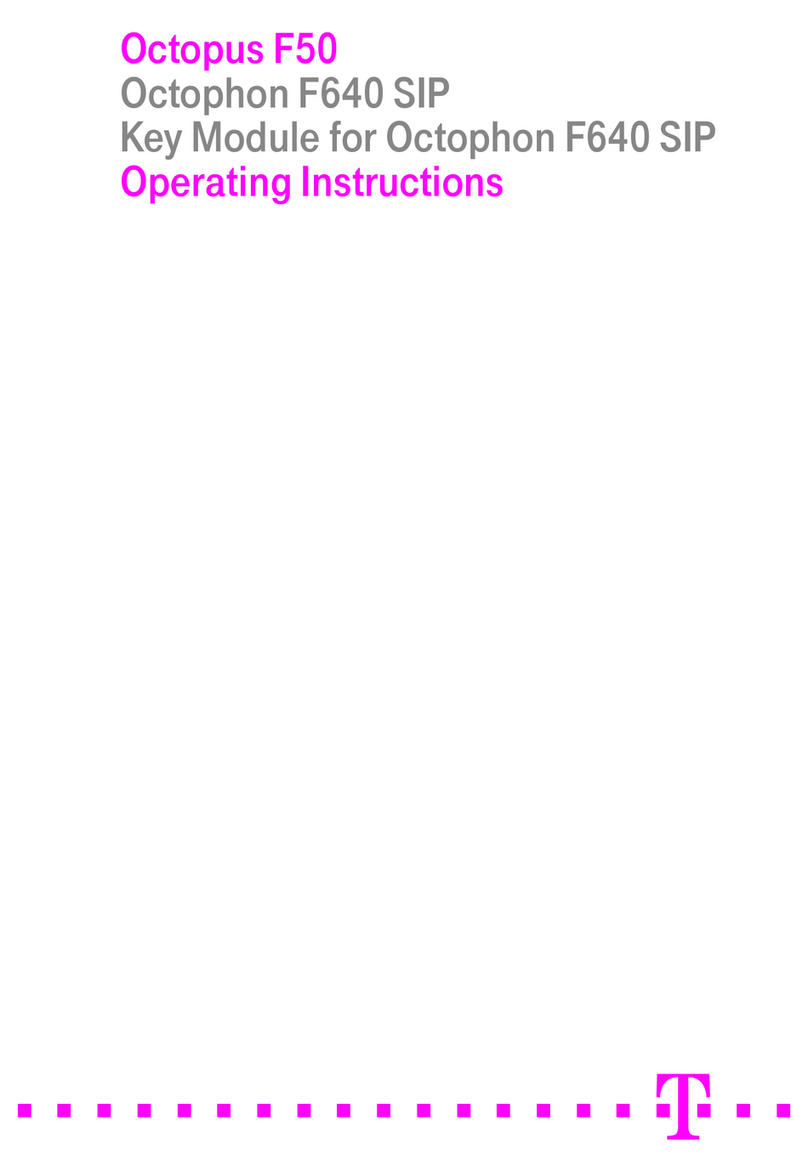
Deutsche Telekom
Deutsche Telekom Octophon F640 User manual

Deutsche Telekom
Deutsche Telekom T_Octopus F200 User manual

Deutsche Telekom
Deutsche Telekom Octopus E 730 User manual
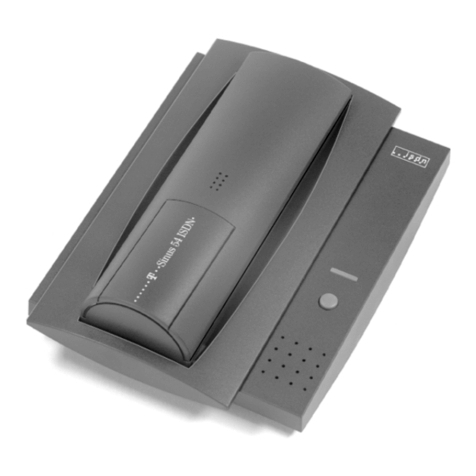
Deutsche Telekom
Deutsche Telekom Sinus 54 ISDN User manual
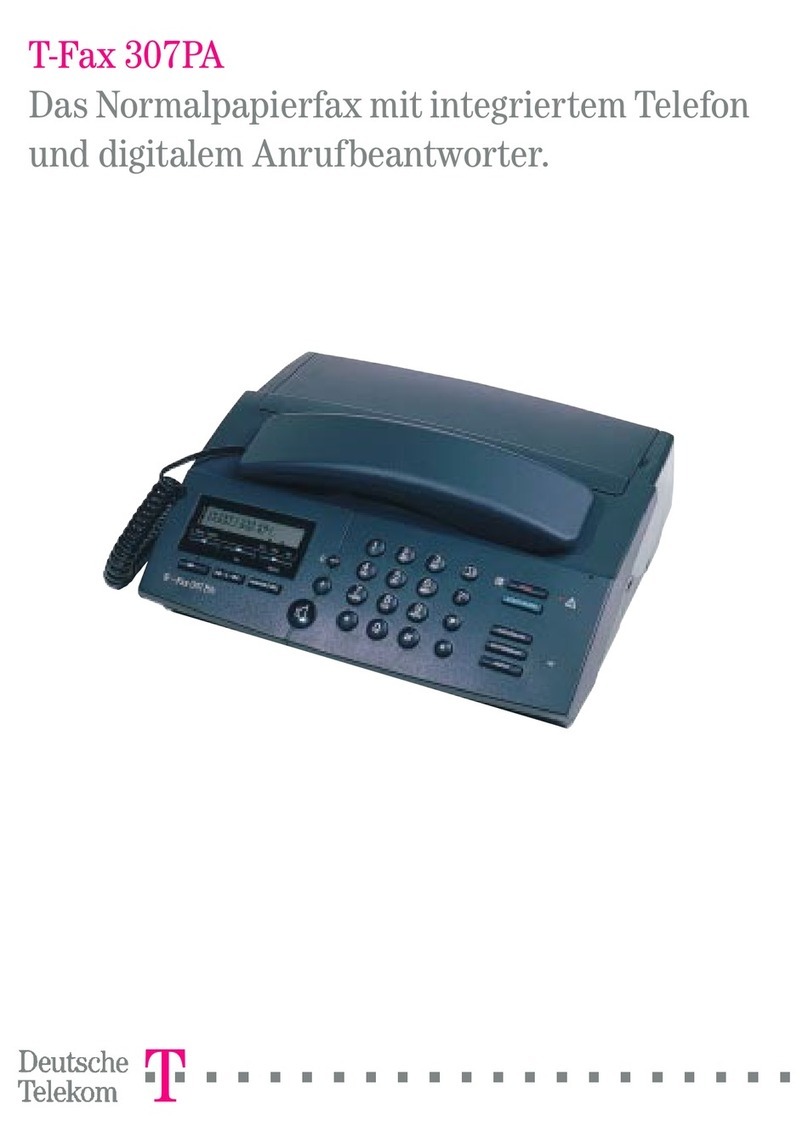
Deutsche Telekom
Deutsche Telekom T-Fax 307PA User manual
